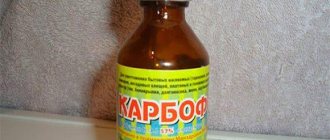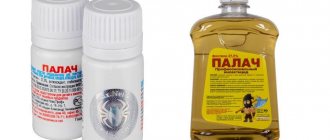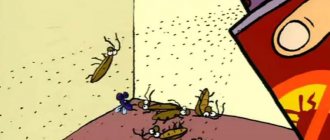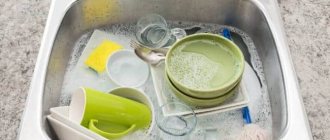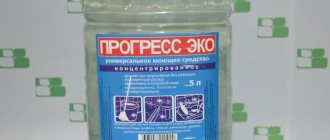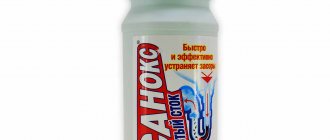Bed bugs are parasitic insects for which the human home is one of the most favorite habitats.
Bedbugs can live on bedding, upholstery, and underwear. The described blood-sucking insects are extremely dangerous for humans: their bites are very painful; bedbugs often carry infections; may harm pets. In addition, insects spoil bedding, leaving their waste products on it.
The remedy for bedbugs “Executioner” is an effective and safe insecticide that will expel not only bedbugs, but also cockroaches, ants and other unwanted “neighbors” from your home.
Composition of the drug
The key active ingredient of the drug is the toxic substance fenthion.
The insecticide was synthesized by German chemists in 1960. The concentration of the substance in “Executioner” is 27.5%. Fenthion is a colorless oil that is poorly soluble in water and technical fluids.
Diluting the poison yourself will be problematic. If fenthion is heated, it will begin to evaporate, forming toxic fumes. Russian standards classify the substance as highly toxic compounds.
It has a characteristic garlic smell. Common uses of fenthion:
- Extermination of insect pests in premises for various purposes;
- Treatment of natural locations to destroy ticks - carriers of encephalitis, borreliosis;
- Processing of clutches of eggs of flies and mosquitoes.
Additionally, the composition of the remedy for bedbugs “Executioner” includes:
- Preservatives and stabilizers;
- Action prolongers;
- Emulsifiers to maintain a homogeneous structure of the composition;
- Perfume fragrance to neutralize garlic odor.
The licensed anti-bedbug product “Executioner” is produced in Germany.
How does the poison work?
The effectiveness of the product lies in the fact that it is a nerve poison for insects: bedbugs and other pests die almost instantly upon contact with the substance.
“Executioner” poisons the pest when it enters its digestive system, or when it simply comes into contact with its body. It is toxic enough to kill harmful insects within 5-7 minutes.
Laboratory tests helped establish how the poison acts on bedbugs: the insect loses the ability to move, the functional state of the respiratory organs deteriorates, and it deteriorates sharply.
Pests that should be especially afraid of the Executioner poison;
- Bedbugs;
- Ants;
- Cockroaches;
- Carpet beetles;
- House flies;
- Fleas and lice;
- Carpet beetles;
- Ticks.
Guaranteed relief from the listed insects for up to two months.
Effect on larvae and eggs
The insecticide for bedbugs "Executioner" is effective not only against adult bedbugs, but also destroys larvae and eggs. Note that eggs are less susceptible to the toxic effects of poison - they are protected by a dense shell. Therefore, to destroy eggs, it is necessary to treat the laying sites with a large proportion of the drug.
But “Executioner” is merciless against larvae even in low concentrations - 1 treatment is enough to destroy a large number of parasites at a time. It is recommended to re-process, since the eggs “mature” in less than a week. Repeated treatment will destroy the larvae that have already hatched.
How many Executioners are required to process a particular room?
You need to calculate the number of Executioner for exterminating insects based on the area of the room and the type of pests themselves. For example:
- To remove bed bugs you need to buy 1 bottle for every 10 square meters. meters of room (rounded up, that is, for 33 sq. m. you need to take 4 bottles) and 1 bottle for each bed. If bedbugs bite every day, that is, there are a lot of them in the apartment, this number must be multiplied by 1.5.
- To remove cockroaches and ants, you need to buy 5 bottles for every 10 square meters. meters of space.
The practice of buyers shows that when a living space is infected, it is not advisable to buy less than 5 bottles. 2-3 bottles are not enough to remove insects. This quantity is purchased either for testing, to make sure that the product really poisons insects, and then buy a full batch, or for preventive treatment of purchased furniture - an armchair or sofa.
How to use the product: instructions for use
Preparation
To begin with, let’s name the surfaces that can be treated during self-disinfestation:
- Gaps between floorboards, parquet joints;
- Skirting boards and gaps between them;
- Side surfaces of upholstered furniture;
- Internal niches of sofas and chair-beds;
- Places where shelves meet walls in wardrobes;
- Mattress covers (inner side);
- Reverse side of wall hangings and tapestries;
- Reverse side of the paintings;
- Bedside tables and cabinet compartments.
The places where parasites live can only be identified with a very careful visual inspection. The location of parasitic life forms can be identified by tiny chitinous scales and excrement that look like tiny black peas.
Before treatment, block the access of pets to the treated area: “Executioner” is a toxic substance that can poison your pet. For small children, access to the disinfestation site should also be blocked.
Important! Food products must be protected from contact with Executioner particles.
How to dilute the product
The next stage of treatment with an executioner for bedbugs involves diluting the substance in the correct dosage. The instructions indicate that to make a deadly poison, it is enough to use 5 ml of the product per liter of cold water. One liter of solution treats no more than 10 square meters.
The easiest way is to dilute the products according to the instructions and treat the area affected by bedbugs as thoroughly as possible, and pour the remaining solution into the toilet after the disinfestation is completed.
How to use and application methods
The Executioner processing process will additionally require:
- Compact sprayer (you can use those that are used to spray the leaves of indoor plants);
- Latex gloves;
- Plexiglas safety glasses.
It is necessary to spray those surfaces on which parasitic insects can live. If the place is hard to reach and you are not sure that the spray particles will get where you need them, take a cotton swab, dip it in the solution and run it along the crack or hard-to-reach corner.
The “Executioner” solution can be used to treat not only interior items, but also bed linen.
It's done like this. “Infected” bedding is sprayed over the entire area and then placed in a large sealed plastic bag, where it is kept for several days. After this, the items are washed in the machine 2-3 times (it is necessary to rinse the laundry thoroughly to remove dead insects and toxin residues).
The effect of the product lasts 2 months: during this time, it is necessary to carry out general cleaning and sanitization of the premises in order to prevent the return of bedbugs and other parasites to the home.
Instructions for using the “Executioner” anti-bedbug product recommend moving the furniture away and treating the areas of the floor underneath it.
If the wallpaper peels off, it is better to tear it off and spray the wall - some insects live under the wallpaper and feed on the glue on the back of the paper. After completing the main stage of disinfestation, prolonged ventilation of the rooms is required.
The minimum duration of ventilation is 60 minutes. At this time, access to the treated area is not recommended. Bedbugs and other pests will die within 5-6 hours after spraying the Executioner product.
Re-treatment of the location is allowed: re-treatment must be carried out 7-10 days after the first spraying.
Repeated disinfestation should be undertaken only in particularly advanced cases, in premises where sanitary safety conditions have been violated for many years.
Can insects be resistant to the Executioner?
To date, there are no known cases of resistance of any insects to fenthion, and therefore to the Executioner. This means that with proper treatment, it can remove any insects from any room.
Cases where the Executioner was unable to remove insects were associated with violations of the rules for using the product. People either took very small quantities of the drug (2-3 bottles for the whole apartment), or sprayed all objects in the room superficially, without trying to get to the insect nests.
Also, the discovery of insects in a room treated by the Executioner may be associated with re-infestation. If bedbugs or cockroaches are found in an apartment 5-6 weeks after treatment, they almost certainly came from neighbors.
How to spot a fake
The market for pest control products is full of counterfeits, and “Executioner” is no exception: the product often becomes the object of counterfeiting.
A real German medicine for bedbugs is sold only in 5 ml bottles. The product must contain instructions for use. Before buying and using a bedbug killer, check the integrity of the packaging: inspect the lid and sealing rings.
The product is safe for any surfaces: it does not violate the integrity of the paintwork, does not lead to cracks, chips and other defects.
Safety precautions for use
Observe the following safety precautions when using the Executioner insecticide:
- During processing, be sure to use safety glasses and latex gloves;
- Isolate the treatment area from children and pets;
- Do not exceed the dosage of the substance stated in the instructions;
- Do not mix the drug with other insecticides;
- Avoid contact of the insecticide with indoor plants and food;
- Rinse treated surfaces thoroughly a few hours after the first treatment.
Help with accidental poisoning
The drug contains toxins and is therefore extremely dangerous if ingested. Symptoms of poisoning are as follows:
- Dizziness and headache;
- Seizure activity;
- Sweating and lacrimation;
- Vomit;
- Acute abdominal pain;
- Diarrhea;
- Heat.
Important! In case of poisoning, it is necessary to give the victim activated carbon, and then take him to a medical facility for gastric lavage.
Reviews about the drug
“The bugs were incredibly annoying.
You wake up - your whole back is bitten, everything is covered in blisters. I changed the linen and washed the sofa with foam and bleach - to no avail. I bought it at the “Executioner” store just at random. I treated it as written in the instructions, and the bedbugs disappeared. I’ve been living peacefully for 3 months already.” (Vladimir Eshtrekov, 70 years old. Yoshkar-Ola). “My husband and I bought an apartment in an old building in the city center. Before that, some dubious asocial comrades lived there. It’s clear that a bug-roach has been planted. They poisoned the reptiles with the “Executioner” for two weeks. It helped. Now you can safely do repairs.” (Elena Avdeeva, 50 years old, Cherepovets).
“I met The Executioner last year. A neighbor at the dacha recommended it. She used it against flies. I treated the house in July to get rid of the infestation of annoying insects in August. In the end, I was pleased with the result; I didn’t even have to buy Velcro tape for flies.” (Nadezhda Lyange, 28 years old. Moscow).
Cost of poison
Affordable cost is one of the reasons for the popularity of “Executioner”. It is noteworthy that the more poison the buyer purchases, the lower the cost of each individual container. And since comprehensive control of bedbugs together with neighbors in the stairwell is considered the most effective, you can cooperate with them even before the start of disinfestation - at the time of purchasing the chemical. The table will tell you how much you can save on such a purchase.
Table - Cost of the product wholesale (data as of January 2018)
| Number of containers, pieces | Total price, rubles | Price of one container, rubles |
| 30 | 2000 | 67 |
| 60 | 3500 | 58 |
| 100 | 5500 | 55 |
The retail cost of one bottle is 70 rubles.
Despite the popularity of the product on the Internet, purchasing the chemical on the domestic market is not so easy. You can get it, but it’s not a fact that the poison you buy won’t turn out to be a fake. Russian importers of the German product buy the insecticide in Germany in large containers, and then package it in small bottles. The reason for secondary packaging is simple: it is much more profitable to sell in miniature containers than in large canisters.
If there are birds in the house, they will have to be given to neighbors or relatives while fighting bedbugs. Parrots and canaries can return to the family nest only a week after secondary treatment. And if the pet usually moves freely around the house, then for the first two weeks after the “move” you should not let it out of the cage.
